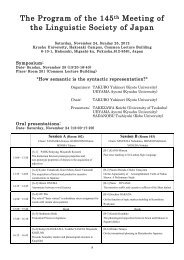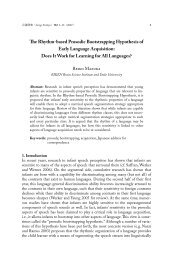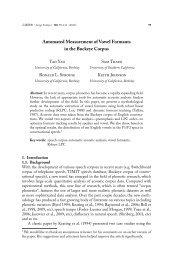第117åæ¥æ¬è§£åå¦ä¼ç·ä¼ã»å ¨å½å¦è¡éä¼ è¬æ¼ããã°ã©ã ã»æé²é PDF ...
第117åæ¥æ¬è§£åå¦ä¼ç·ä¼ã»å ¨å½å¦è¡éä¼ è¬æ¼ããã°ã©ã ã»æé²é PDF ...
第117åæ¥æ¬è§£åå¦ä¼ç·ä¼ã»å ¨å½å¦è¡éä¼ è¬æ¼ããã°ã©ã ã»æé²é PDF ...
Create successful ePaper yourself
Turn your PDF publications into a flip-book with our unique Google optimized e-Paper software.
117 101<br />
OFPMII<br />
<br />
1 2 3 2 3 2 <br />
3 1<br />
1<br />
2 <br />
3 <br />
<br />
Cilia show variations in axonemal structure, motility, and the number per<br />
cell, and are classified into subtypes. Depending on the tissue origin and<br />
differentiation status, one cell type appears to adopt a certain ciliary subtype. We<br />
are characterizing unique, multiple 9+0 cilia in choroid plexus epithelial cells<br />
CPECs to elucidate the mechanism of ciliary diversification. Proteomic analysis<br />
of CPEC cilia identified 868 proteins, including several molecules implicated in<br />
ciliary motility such as Rsph9. Immunostaining for Rsph9 demonstrated that the<br />
molecule localized to a subpopulation of CPEC cilia. Live imaging of choroid<br />
plexus tissue exhibited that some CPEC cilia could beat vigorously at the neonatal<br />
stage, whereas others were nonmotile. The beating pattern, frequency, amplitude,<br />
and orientation were also variable and different from those of typical 9+2 cilia of<br />
ependyma. Transmission electron microscopy revealed the coexistence of 9+0 and<br />
9+2 configuration in neonatal CPEC. Overall, our results demonstrated striking<br />
molecular, functional, and ultrastructural heterogeneities in neonatal CPEC cilia,<br />
providing substantial novel insight on ciliary diversification.<br />
OFPMII<br />
PACAP <br />
1,2 1 1 1 1 <br />
1 1 2 3 3 3 <br />
1<br />
1<br />
2 3 <br />
<br />
<br />
PACAPKO<br />
PACAP <br />
PACAP <br />
PACAP <br />
PACAP <br />
PACAP cAMP<br />
PKA 30 <br />
PACAP AC<br />
<br />
AQP5 <br />
PACAPKO AQP5 <br />
PACAP 30 AQP5 <br />
AQP5 <br />
PACAP AC <br />
PACAP AC/cAMP/PKA <br />
AQP5 <br />
<br />
OGPMI<br />
microCTmicroMRI <br />
<br />
1,2 3 4 5 6 7<br />
1<br />
JST 2 3 <br />
4<br />
5 6 <br />
7 <br />
<br />
<br />
microCT microMRI <br />
<br />
<br />
microCTmicroMRI <br />
<br />
<br />
microCT CTmicroMRI <br />
<br />
<br />
CTMRI <br />
<br />
CT <br />
0.1<br />
mm <br />
<br />
<br />
OGPMI<br />
<br />
OGPMI<br />
HyperDry <br />
1 1 1 1 2<br />
1<br />
2 <br />
3<br />
<br />
HyperDry HD<br />
HD FD <br />
<br />
φ25 mm <br />
Swinnex, SX0002500, <br />
50 ml <br />
<br />
1 ml<br />
50ml 1 ml <br />
185 mmAq730 mmAq<br />
133 mmAq <br />
<br />
730 mmAq FD=3.7 ul/min, HD=1.5 ul/min FDHD <br />
FD <br />
HD FD <br />
<br />
<br />
OGPMI<br />
<br />
1 2 2 2 2 <br />
2 2 2 2 2 2 <br />
1 1 1 1<br />
1<br />
2 <br />
<br />
<br />
<br />
<br />
8 BALB/c <br />
4 mm <br />
<br />
3 0.1 mL <br />
Scion image <br />
6 <br />
1.71 14 0.38 <br />
3 <br />
0.49 0.65 0.81 <br />
7 0.80 6 0.86 <br />
9 1.19 14 <br />
3 14







